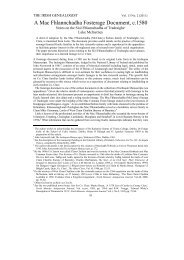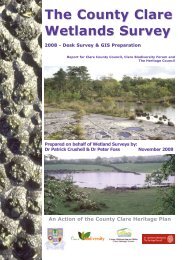Documents from the Thomond Papers at Petworth House Archive1 ...
Documents from the Thomond Papers at Petworth House Archive1 ...
Documents from the Thomond Papers at Petworth House Archive1 ...
You also want an ePaper? Increase the reach of your titles
YUMPU automatically turns print PDFs into web optimized ePapers that Google loves.
<strong>Documents</strong> <strong>from</strong> <strong>Thomond</strong> <strong>Papers</strong>, <strong>Petworth</strong> <strong>House</strong> Archive<br />
Brian Bóroimhe) reloc<strong>at</strong>ing <strong>from</strong> <strong>the</strong>ir Irish est<strong>at</strong>es, centred on <strong>the</strong> manor<br />
of Bunr<strong>at</strong>ty, to England. Bunr<strong>at</strong>ty Castle had originally passed <strong>from</strong> Clann<br />
Mhic Chonmara to <strong>the</strong> dynastic lineage of <strong>the</strong> Uí Bhriain during <strong>the</strong> sixteenth<br />
century. 7 As a chief dynastic family of north Munster since medieval<br />
times, <strong>the</strong> Uí Bhriain retained <strong>the</strong>ir prominence and independence as <strong>the</strong><br />
ruling family of <strong>the</strong> <strong>Thomond</strong> Gaelic lordship until Murchadh Ó Briain<br />
renounced his claim to kingship and was cre<strong>at</strong>ed first earl of <strong>Thomond</strong><br />
and first baron Inchiquin, in 1543. 8 It was not until Donough O’Brien,<br />
known to <strong>the</strong> English as <strong>the</strong> ‘Gre<strong>at</strong> Earl’, 9 firmly allied himself as a loyalist<br />
and supporter of English law and administr<strong>at</strong>ion and commander of royal<br />
forces during <strong>the</strong> Nine Years War (1595–1603), th<strong>at</strong> <strong>the</strong> former kingdom of<br />
<strong>Thomond</strong> underwent anglicis<strong>at</strong>ion.<br />
During <strong>the</strong> Irish Confeder<strong>at</strong>e Wars (1641–1652) Barnaby O’Brien, sixth<br />
earl of <strong>Thomond</strong>, left Co. Clare after <strong>the</strong> surrender of Bunr<strong>at</strong>ty Castle to<br />
a Parliamentarian force in 1646 and joined his wife and son Henry <strong>at</strong><br />
Gre<strong>at</strong> Billing in Northamptonshire. 10 After <strong>the</strong> Restor<strong>at</strong>ion of Charles II in<br />
1660, Barnaby’s son Henry, <strong>the</strong> seventh earl of <strong>the</strong> <strong>Thomond</strong>, inherited his<br />
fa<strong>the</strong>r’s est<strong>at</strong>e in <strong>Thomond</strong> which amounted to 85,000 acres in Co. Clare. 11<br />
From this point <strong>the</strong> earls of <strong>Thomond</strong> held substantial interests in England<br />
and had become absentee landlords to <strong>the</strong>ir Irish est<strong>at</strong>e, residing <strong>at</strong> Gre<strong>at</strong><br />
Billing. In 1741 Henry O’Brien, eighth earl of <strong>Thomond</strong>, 12 died without<br />
issue and left his Irish est<strong>at</strong>es to his nephew Percy Wyndham, son of his<br />
wife’s sister. As a condition of <strong>the</strong> bequest, Percy was required to take <strong>the</strong><br />
additional name of O’Brien and was cre<strong>at</strong>ed earl of <strong>Thomond</strong> and baron<br />
of Ibracken in 1756. 13 On <strong>the</strong> de<strong>at</strong>h of Percy without issue in 1774, <strong>the</strong> title<br />
of earl of <strong>Thomond</strong> became extinct and <strong>the</strong> est<strong>at</strong>es passed to his nephew<br />
George Wyndham, third earl of Egremont.<br />
Some of <strong>the</strong> documents contained in <strong>the</strong> <strong>Petworth</strong> <strong>House</strong> collection have<br />
been c<strong>at</strong>alogued and are available for public consult<strong>at</strong>ion <strong>at</strong> <strong>the</strong> West Sussex<br />
Record Office in Chichester. 14 The <strong>Petworth</strong> <strong>House</strong> c<strong>at</strong>alogue is testimony<br />
7 George U. Macnamara, ‘Bunr<strong>at</strong>ty, Co. Clare’ in Journal of <strong>the</strong> North Munster Archaeological<br />
Society, iii, 4 (1915), pp 220–286, p. 267. The background to this transfer is obscure and<br />
subject to conjecture. The annals of Friar John Clyn record th<strong>at</strong> Bunr<strong>at</strong>ty was destroyed by a<br />
joint Mac Conmara and Ó Briain <strong>at</strong>tack in 1332: ‘Eodem vero tempore, castrum de Bonr<strong>at</strong> (quod<br />
multorum judicio inexpugnabile videb<strong>at</strong>ur); per O’Brein et Mc Nemare destruitur’. Annals of<br />
Friar John Clyn, sub anno, 1332.<br />
8 John Ainsworth (ed.), The Inchiquin Manuscripts (Dublin, 1961), no.885 [1 July, 1543], p. 272.<br />
9 Brian Ó Dálaigh, ‘From Gaelic Warlords to English Country Gentlemen: The O’Briens of<br />
<strong>Thomond</strong> 1543–1741’ in The O<strong>the</strong>r Clare, xxv (2001), pp 40–42, p. 41.<br />
10 Ibid., p. 42.<br />
11 Ibid.<br />
12 Henry was cre<strong>at</strong>ed Viscount Tadcaster in 1714 and served as MP for Arundel 1710–1714 and<br />
Lord Lieutenant of Essex in 1722–1741.<br />
13 The <strong>Petworth</strong> <strong>House</strong> Archive: Vol 1: A C<strong>at</strong>alogue, p. viii.<br />
14 See Ibid and subsequent volumes (2–4) detailing <strong>the</strong> full archival collection. The fifth volume<br />
is available only in electronic form.<br />
9

















